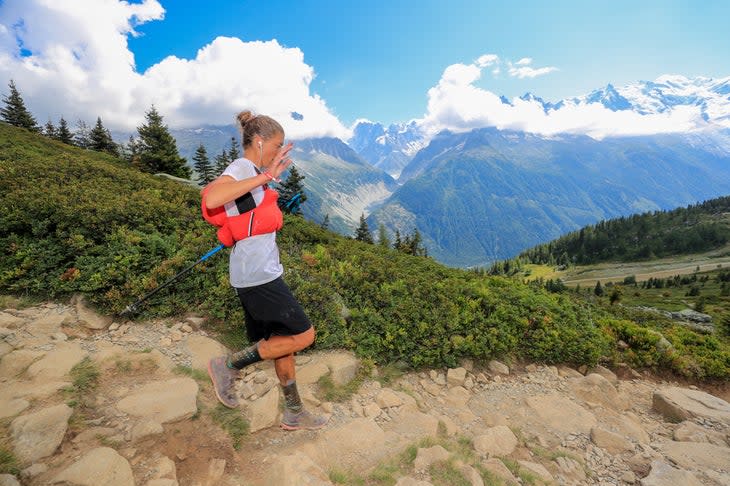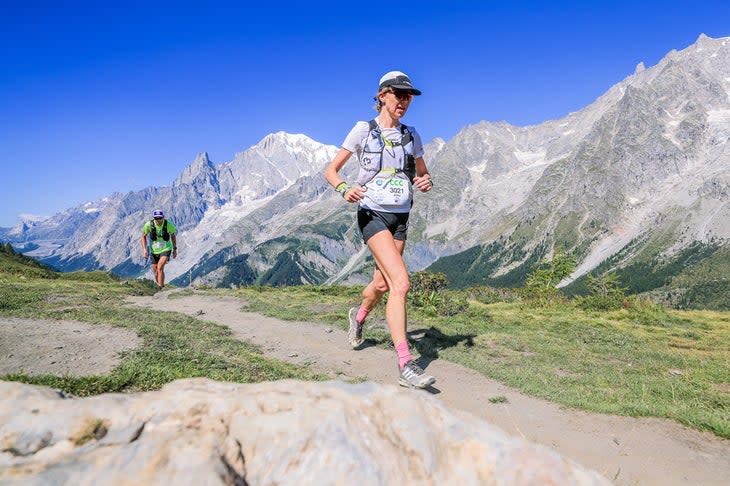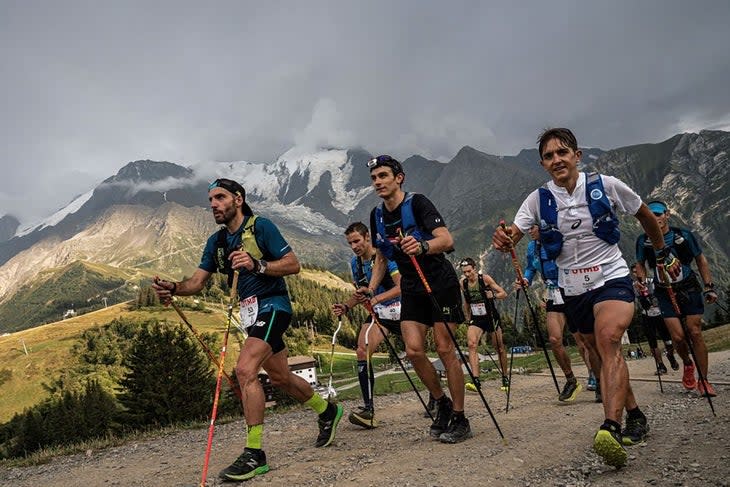New Study Shows What Happens To Your Body Post-Ultra
This article originally appeared on Trail Runner
Ultramarathons can induce physiological crapstorms. You don't need a study citation for that statement, especially if you've ever seen post-race urine samples. I have seen a few pee cups after hot, grueling ultras (don't ask), and they could serve as the set location for the next big game show: "Coca Cola, Tomato Soup, Or Urine?" In my fantasy, Bob Barker comes out of retirement to host.
The brown urine that some athletes experience after hard ultra events (especially those in heat) is an extreme example of post-race physiological breakdown. The brownish tint may be severe dehydration, mixed with the byproducts of muscle damage. Red is especially dangerous and hopefully rare, possibly indicative of blood (or pre-race beets). Sometimes it comes with pulp, and you don't want to know what that is.
One of the most eye-opening studies I have ever seen was published in 2012 in the Wilderness Environmental Medicine journal. At the Western States 100 in 2010, 216 of 328 finishers underwent a post-race blood test to measure creatine kinase, an enzyme found in skeletal muscle, used as a proxy for muscle breakdown. The reference range goes up to 198 units per liter. Many emergency rooms will admit patients (or refuse to discharge those receiving inpatient treatment) for levels above 5000 units per liter, especially if accompanied by symptoms of rhabdomyolysis. The average creatine kinase value of Western States finishers was 32,956 units per liter (many hospital tests don't even measure above 30,000).
RELATED: Should Women Fuel Differently Than Men?
That's just the start! 13 athletes had CK values over 100,000 units per liter, with one athlete topping out at 264,500. If you want to send that athlete a gift, I suggest a voucher for free ice cream from the hospital cafeteria. But interestingly, the super high values were not necessarily associated with clinical outcomes–the body seems to have some protective mechanisms that make post-ultra physiology into a unique subset of medical practice and exercise physiology research. WOW!
There was no association with finishing time, age, gender, or running experience. Some athletes just seemed to be predisposed to higher levels of CK and muscle breakdown than others. Subsequent studies have expanded on our understanding of CK specifically, but we still face a debated and important question: what causes variance in post-ultra physiological responses?
RELATED: 5-Point Training Checklist For Almost Any Ultra

Post-Ultra Muscle Breakdown: Study Overview
A fantastic new study led by Dr. Nicholas Tiller (Twitter profile / Book / Website) published in the Medicine and Science in Sports and Exercise journal added to our knowledge, examining the role of gender on these physiological responses. I love this study for two main reasons. First, it takes a broad look at physiological metrics before and after ultras, providing clues to how we might limit the impact of the races on the body and facilitate recovery post-race. Second, it highlights female athletes, which is key in a sport that has a high skew toward male participants (particularly in research studies).
The study design was straightforward and elegant. 10 women and 43 men participated. While that discrepancy seems excessive, it can be nearly impossible to ensure equal participation in these studies due to the offset in overall participation/lottery systems. Part of the reason that the study is so great is that it faces this challenge head-on, trying to add to the field of knowledge so that future studies can get closer to equal participation.
These athletes underwent the following tests before and after the UTMB or CCC ultra races in Chamonix, France, with testing organized by a research team from the Mayo Clinic:
Blood sampling, including biomarkers that are proxies for muscle damage
Pulmonary and respiratory muscle function
Transthroacic ultrasound, which can measure pulmonary edema and cardiac function
8 of the women finished the race, and the researchers selected the 8 men that were closest to the mean finishing time of the women for data analysis, in order to control for the effect of race time on physiological responses.
What do you think happens next? I was unsure when I first saw the design. I knew there'd be evidence of major physiological responses, but how would they vary? In coaching, I think I see variable responses that have some overlap with gender, but I am painfully aware that my brain has a propensity to spot patterns that aren't statistically relevant. I mean, I look at the stars and the only constellations I see involve Harry Styles doing various dance moves.
RELATED: 10 Ways To Improve Fatigue Resistance In Ultras

Here’s What Happens To Your Body During An Ultra: Study Results
The results were striking (Dr. Tiller summarized them in a terrific 9-tweet thread, check that out here). I think there are two main findings that are important for our purposes. Our purposes: (1) understanding exercise physiology and (2) seeing Harry Styles in the fabric of the cosmos.
First, YES, it's true: Ultras are physiological crapstorms! For both men and women, ultras "evoked significant increases in skeletal muscle, cardiac, and renal biomarkers, and significant decreases in various aspects of respiratory and cardiopulmonary function." Figures 3 and 4 provide wonderful visualizations of the changes, which show muscle damage going up and lung function going down, among other things.
But look closely at those figures for the second point. Men and women responded differently across many of the variables, with an overarching pattern of women having a lower effect size for some of the metrics. For example, while both men and women had increased fluid in the lungs, the change had a higher effect size in men. In addition, only men showed an increase in creatinine, a waste product in the blood that would normally be filtered by the kidneys, possibly indicative of higher internal strain. Put it all together, and men demonstrated a higher pooled effect size on the physiological metrics (0.86 v. 0.63).
RELATED: 10 of the Worst Training Tips You Hear in Running
That is SO DAMN COOL.
Ultras are hard on everyone, but at least in this study population and for the specific variables measured, there generally seems to be a greater effect size in the male participants. That overlaps with what I see in coaching. Nearly every case of rhabdo I have seen for athletes I coach happens in male athletes. And the men often seem a bit more muscularly wrecked post-race. So the results pass the smell test for me, unlike my pile of running shoes, which smell like Chernobyl.
Before thinking about the practical implications of the research, let's throw some disclaimer turds in the hydration pack. The researchers acknowledge that the statistical methods meant to control for duration mean that they cannot control for other variables, like cardiorespiratory fitness. That could mean that these results are not generalizable across every study, though more research is needed. Also, the sample size isn't huge, again pointing to the need for more research. Finally, as the Western States study showed, these metrics have tons of individual variability. While gender plays a role, there may be numerous other factors that are driving the variance, and it will be impossible to be sure without more research. I'd love to see studies that measure more variables, across more athletes, over longer time horizons.
In other words, I'm arguing that someone should give these researchers (and badass bosses like them) more money to do cool shit.
RELATED: The Science of High Volume vs. High Intensity Training

Training Takeaways
I have two major training takeaways from the research, both of which will be incredibly generalized. First, based on the effect size differences, it may be ever so slightly more important for the average man to emphasize training approaches that may be protective against breakdown relative to the average woman. What that means for athletes I coach: in the 6-8 weeks pre-race, the male athletes will usually do a higher proportion of vert, particularly on the weekends, along with slightly higher sustained volume. That could help limit breakdown on race day. However, gender is just one of many differences across athletes, and other variables like muscle fiber typology and training history play a big role too.
Second, for all athletes, ultras are major physiological stresses even if they don't feel like it. Many of the variables measured by the researchers have long tails–while they undergo immediate changes like those measured in the study, those changes can also persist for days and weeks. The researchers were limited by equipment they could use in remote areas, so they didn't look at longer-term metrics for the endocrine and nervous systems. But it's likely that the changes seen in the study overlap with just about everything you can measure.
So make sure you recover after ultras, no matter what your background. Our general rule is 1 day of complete rest for every 10 miles raced to start (100 miles = 10 days). After that, the same period should be spent doing easy activity and strides to rebuild speed. Only after that window should an athlete return to somewhat normal training, while listening to their bodies, and limiting excessive long runs.
Post-ultra physiology is not just about athletes doing long races. This field of study is wonderful because it puts human physiology into a pressure cooker of stress, and the responses could have broad implications for human health and performance that go far beyond running races.
So yes, ultras induce physiological crapstorms. But there is a lot we can learn in the eye of a crapstorm.
RELATED: Back to Back Long Runs: Next Level Ultra Training (If Done Right)
David Roche partners with runners of all abilities through his coaching service, Some Work, All Play. With Megan Roche, M.D., he hosts the Some Work, All Play podcast on running (and other things), and you can find more of their work (AND PLAY) on their Patreon page starting at $5 a month.
For exclusive access to all of our fitness, gear, adventure, and travel stories, plus discounts on trips, events, and gear, sign up for Outside+ today.

